As the climate becomes more unpredictable and arid zones expand due to desertification, efficient water use is no longer an option—it’s a necessity. For farmers in regions like the Middle East, North Africa, parts of India, Australia, and southwestern U.S., traditional irrigation methods are proving unsustainable. This is where drip irrigation systems shine.
Drip irrigation, also known as micro-irrigation, delivers water directly to the root zone, minimizing evaporation and runoff. When combined with precision timing and filtration systems, drip systems can reduce water usage by up to 60% compared to sprinkler or flood irrigation.
But how do you choose a drip irrigation manufacturer that suits your specific environmental challenges, especially in arid or semi-arid climates? This blog covers the top 7 globally recognized manufacturers, highlighting their strengths, technologies, and suitability for water-scarce areas.
Contents
- 1 What to Look For in a Drip Irrigation Manufacturer for Dry Zones
- 2 Top 7 Drip Irrigation System Manufacturers for Arid Regions
- 3 Performance Charts
- 4 Applications: Vegetables • Dates • Grapes • Citrus • Row Crops
- 5 Farmers’ Real Experiences
- 6 Choosing the Right System for Your Arid Farm
- 7 Key Considerations Before Buying
- 8 Frequently Asked Questions (FAQ)
- 9 Conclusion
What to Look For in a Drip Irrigation Manufacturer for Dry Zones
Before diving into the list, it’s important to understand the decision-making factors that matter most in desert and semi-arid agriculture:
Low-pressure efficiency: Some farms lack strong water pressure. Ideal systems operate effectively even under 0.5–1 bar.
Anti-clogging technology: Dust, sand, and calcium can quickly clog emitters. Self-flushing or pressure-compensating emitters are vital.
UV and salt resistance: High UV and salinity levels degrade substandard tubing.
Scalability&modularity: Arid regions often expand irrigation in stages—modular systems reduce upfront costs.
Technical support & local availability: On-ground support can make or break implementation success.
Top 7 Drip Irrigation System Manufacturers for Arid Regions
1. Netafim
Country: Israel
Founded: 1965
Website: netafim.com
Logo:
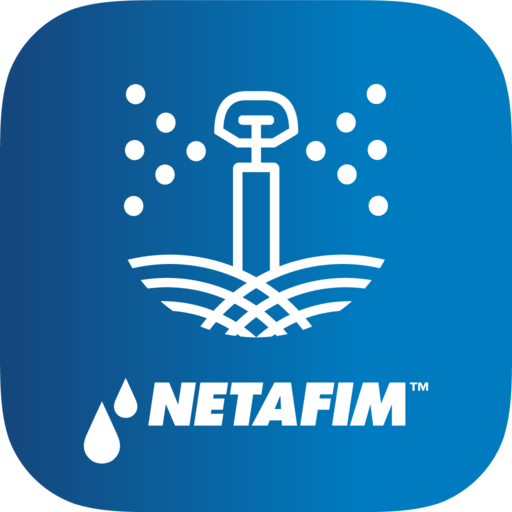
Why they lead:
Netafim is often considered the gold standard in drip irrigation. Developed in the Negev Desert, their systems were born in arid conditions and are tailored to handle them. They offer pressure-compensating drippers, anti-clog emitters, and advanced crop-specific kits.
Key Technologies:
DripNet PC and UniRam™ systems with root intrusion barriers
Digital irrigation platforms (NetBeat™)
Ultra-violet and chlorine-resistant materials
Best for: Large commercial farms, desert orchards, greenhouse cultivation in dry climates
2. Jain Irrigation Systems Ltd.
Country: India
Founded: 1963
Website: jains.com
Logo:
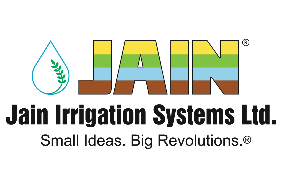
Strengths:
Serving over 120 countries, Jain offers robust low-cost solutions perfect for smallholder farmers. Their kits are engineered for minimal water pressure and are often solar-compatible.
Innovations:
Jain Logic™ remote monitoring for irrigation
Jain Turbo Excel PC Dripline
In-line and on-line drippers with clog resistance
Best for: Small-to-medium farms, subsidy-backed projects, high salinity zones in South Asia and Africa
3. Rain Bird Corporation
Country: USA
Founded: 1933
Website: rainbird.com
Logo:

Focus:
Though originally known for turf and landscape irrigation, Rain Bird offers solid commercial drip solutions. Their XF Dripline series is ideal for arid residential agriculture and peri-urban farms.
Why it matters:
Pressure-regulated emitters
Heavy-duty UV-resistant polyethylene
Designed for harsh water conditions
Best for: Urban rooftop farms, vineyards, and small plots in California, Arizona, and similar climates
4. Rivulis Irrigation
Country: Israel
Founded: 1966 (formerly John Deere Water)
Website: rivulis.com
Logo:

Known for:
Innovation in subsurface drip irrigation (SDI) for row crops and orchards. Their T-Tape and D5000 PC driplines are known for long-lasting performance in sandy soils.
Advantages:
FieldNET™ automation system
Hydro PCND dripline: excellent in sloped terrain
Local manufacturing hubs across Africa and Latin America
Best for: Date farms, cotton fields, and citrus groves in extremely dry climates
5. Toro Ag Irrigation (a division of Toro Company)
Country: USA
Founded: 1914
Website: https://www.toro.com/en
Logo:

Why Choose Toro:
Their Aqua-Traxx® line is widely adopted in arid farmlands due to affordability, easy flushing, and salt-tolerant construction.
Specialties:
Custom emitter spacing
Flow regulation for long lateral lengths
Compatibility with biodegradable mulch
Best for: Field crops in large-scale operations, e.g., melons, onions, cotton
6. Antelco
Country: Australia
Founded: 1985
Website: antelco.com
Logo:
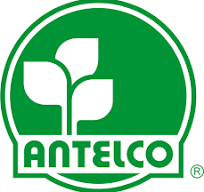
Ideal for:
Farmers in extremely hot, saline, and UV-intensive environments. Their micro irrigation systems are excellent for hobby farms and semi-arid estates.
Features:
Barbed and threaded micro jets
Low-flow drippers for drip tape and tubing
UV-stabilized plastic resins
Best for: Home gardens, arid orchards, backyard agriculture
7. DripWorks (USA)
Country: USA
Founded: 1992
Website: https://www.dripworks.com/
Logo:
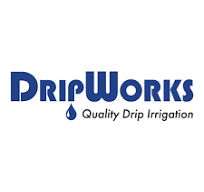
Why it’s rising: DripWorks has become a trusted provider for small farms and DIY growers across arid regions in North America. Their user-friendly kits and online planning tools make it easy for growers to implement effective drip systems.
Differentiators: Beginner-friendly online tools, complete starter kits, custom design support, strong community education content
Best for: Small commercial farms, backyard growers, educational farms in dry climates
Performance Charts
Dripper Flow Rate Comparison
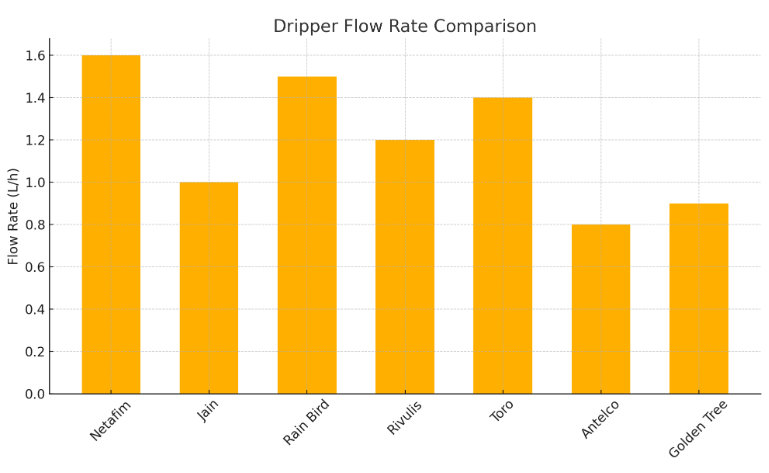
This chart shows the average emitter output in liters per hour. Brands like Netafim (1.6 L/h) and Rain Bird (1.5 L/h) offer higher-flow options suitable for crops with greater water demand or coarser soil textures. In contrast, Antelco (0.8 L/h) and DripWorks (0.9 L/h) provide lower-flow systems that are ideal for sandy soils and slower percolation, helping to prevent water loss due to runoff or deep seepage.
Salt Resistance Level (1-10)
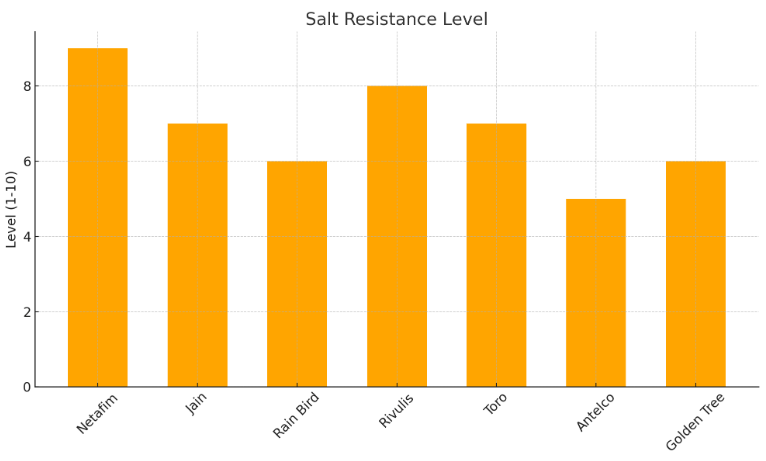
Salinity in irrigation water can severely impact both the crop and the equipment. Netafim (9/10) and Rivulis (8/10) stand out for their strong resistance to saline conditions, making them ideal for regions using brackish or well water. Mid-range resistance from Jain and DripWorks (6–7/10) suits general-purpose applications with moderate water quality.
UV Resistance Level (1-10)
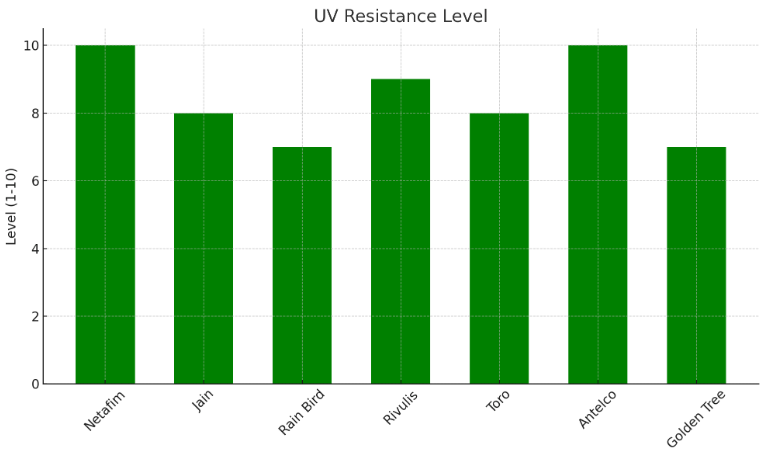
High solar radiation in arid climates can degrade plastics quickly. Netafim and Antelco lead with top-tier UV protection (10/10), ensuring longevity even in direct sun exposure. DripWorks (7/10) performs well for its price point, offering decent durability for small to medium farms.
Together, these charts provide essential insights for choosing the right system based on environmental challenges. A farm facing high UV and salt levels would benefit most from Netafim or Rivulis, while budget-conscious users in moderately harsh climates might turn to Jain or DripWorks.
Applications: Vegetables • Dates • Grapes • Citrus • Row Crops
Whether you’re growing onions in Sudan, grapes in northern Mexico, or citrus in Iran, drip irrigation helps you control water, reduce disease spread, and stabilize yield.
Farmers’ Real Experiences
“Switching to subsurface drip from Rivulis helped us cut water use by 50% in our California almond orchard.”
— Carlos M., USA
“Jain’s low-pressure kit saved our tomato crop during a drought season in Maharashtra.”
— Leela B., India
“Netafim’s tech support was a lifesaver. They helped us design a reliable drip plan even when our water source was intermittent.”
— Youssef K., Tunisia
Choosing the Right System for Your Arid Farm
Here’s a quick decision matrix:
| Condition | Recommended Manufacturer | Reason |
| Sandy soil + high temp | Netafim / Rivulis | Anti-clog tech, UV resistance |
| Low budget, small area | Jain / Golden Tree | Low-pressure kits, affordable |
| Commercial orchard | Toro / Rivulis | Flow-regulated driplines |
| Greenhouse in hot zones | Antelco / Rain Bird | Compact, UV-stable micro-irrigation |
| Large desert farm | Netafim / Jain | Modular, scalable, tech-enabled |
Key Considerations Before Buying
Water source stability: Can you install filters and backup tanks?
Local distributor support: Spare parts and maintenance access matter.
Soil type: Sand vs. clay influences emitter selection.
Crop type and spacing: Decide emitter flow rate and placement accordingly.
Budget vs. longevity: Cheap systems often degrade quickly under UV.
Frequently Asked Questions (FAQ)
Q1: Which system works best with solar water pumps?
A: Jain and DripWorks offer solar-compatible kits with low pressure requirements.
Q2: What if my water has high salinity?
A: Look for systems with salt resistance level above 7, such as Netafim or Rivulis.
Q3: Can I use these systems for orchards?
A: Yes, Toro and Rivulis offer flow-regulated options ideal for long rows in orchards.
Q4: How long do these systems last?
A: With proper maintenance, UV-resistant systems like those from Netafim and Antelco can last over 10 years.
Conclusion
Drip irrigation isn’t just a trend—it’s a lifeline for farmers in arid and semi-arid regions. With the right manufacturer and setup, you can achieve up to 90% water use efficiency, healthier crops, and stronger financial returns.
Whether you’re running a desert date farm or a semi-urban vegetable plot, the top 7 manufacturers listed above offer solutions tailored to your environment and scale. Prioritize technical support, materials resilience, and cost-to-benefit ratio to make the most informed decision.
Looking for assistance with your irrigation project? At MINNUO, we understand the unique challenges faced by farmers in arid and semi-arid climates. That’s why we provide dependable, customizable agricultural solutions—including smart drip irrigation systems, expert guidance, and responsive after-sales support—to help you maximize every drop of water. Whether you’re starting a small plot or scaling a large operation, MINNUO is here to help you grow sustainably. Reach out and we’ll help you choose the most suitable drip irrigation system based on your location, soil, crop, and budget.

